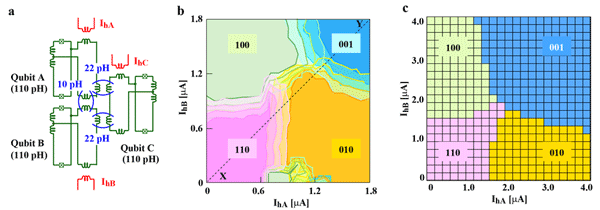ED6-3-INV
Experimental Demonstration of NOR Circuit Using Superconducting Flux Qubit at 10mK
Dec.3 17:50-18:15 (Tokyo Time)
The National Institute of Advanced Industrial Science and Technology1
Yokohama National University2
Quantum annealing is unique computing to utilize tendency of physical system having the lower energy configuration. For scalable system, we have investigated an application-specific annealing computing (ASAC) architecture [1] with dedicated low-Jc process for qubit. By statically combing three qubits based on ASAC architecture, a NOR circuit was established (Fig. 1a). Its Hamiltonian is modified by flux injections through currents Ihi(i=A, B,C) and takes four minimum, where a relationship of persistent currents in the qubits correspond to a logic in NOR. Qubit states are evaluated using a readout circuit consisting of a quantum flux parametron and a superconducting quantum interference device. Sample was fabricated in the clean room for analog-digital superconductivity (CRAVITY) utilizing four-layer Nb technology including Nb/AlOx/Nb Josephson junction with critical current density of 1 μA/μm2. With careful tuning of bias condition in the readout circuit, state probability in each qubit (0/1 state) was evaluated at 10 mK. The quantum annealing was carried out by applying a current-induced transverse field, where the effect was modified by rise time of the current pulse. We associated combination of qubit states with the logic element. Figure 1b shows measured heat map of the logic in NOR. Color gradation corresponds to the probability of generation in each logic element. From analysis in histogram along X-Y line, we found a degeneracy point, where all logic element was randomly obtained. Each logic element is reproduced by taking account offset current from this point. For example, logic “001” is achieved by applying IhA = 1.8 μA and IhB =1.8 μA. Qubit states in Fig. 1a was analyzed by SPICE and corresponding logic element in NOR was mapped (Fig. 1c). The feature was consistent with experiment. Moreover, the degeneracy point was reproduced in SPICE by taking account of thermal noise. We also confirmed NAND operation using the same sample.
References
[1] M. Maezawa et al., J. Phys. Soc. Jpn. 88 (2019) 061012.
Acknowledgements
This paper is partly based on results obtained from a project commissioned by the New Energy and Industrial Technology Development Organization (NEDO), Japan. The authors appreciate K. Inomata, N. Watase and K. Kikuchi for their heartfelt cooperation.
Keywords: superconducting flux qubit, NOR, quantum annealing, SPICE
